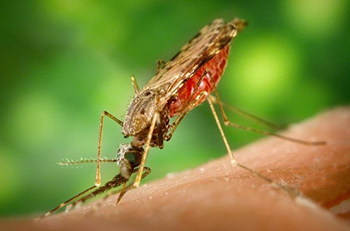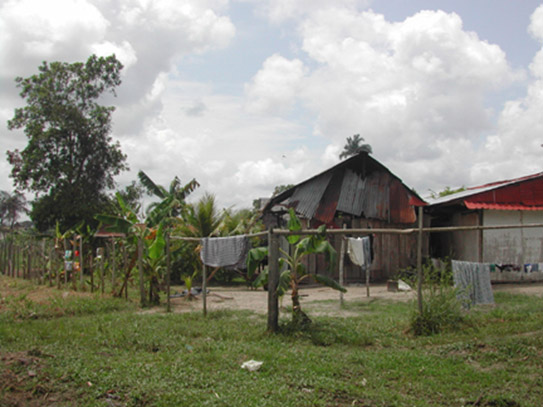
By:
- Kim McDonald
Published Date
By:
- Kim McDonald
Share This:
Green ‘Pond Scum’ Holds Hope for Producing Edible Vaccine Against Malaria
Vaccine development among focuses of new Center for Food & Fuel for the 21st Century
Most people know by now that algae are a promising source of biofuels that could supplement and eventually replace the world’s declining reserves of oil.
But UC San Diego biologists working on algal biofuels who joined forces with another team at the School of Medicine studying tropical diseases have discovered another use for algae. They’ve found that these single-celled green factories, often dismissed as “pond scum,” are capable of inexpensively producing vaccines that might be able to protect the 2 billion people on the planet at risk for developing malaria.
The researchers published their findings in mid-May, just days after concluding a three-day conference that brought some 300 plant geneticists from around the country here to discuss ways of using plant genomics to improve agriculture and the production of renewable transportation fuels to sustain the world’s rapidly growing population.
Developing Crops Engineered for Arid Regions Could Spark Second ‘Green Revolution’ Keynote Speaker Tells Plant Geneticists
By Kim McDonald
Improving the agricultural productivity of small farmers around the world is the best way to feed the world’s growing population and provides the greatest benefit for the poor in Third World countries.
That’s the conclusion of Rob Horsch, deputy director of agricultural research and development at the Bill & Melinda Gates Foundation, who told plant geneticists at a recent symposium here that their efforts to develop higher yield crops that can be engineered to grow in arid regions or areas with little nitrogen in the soil could lead to a second Green Revolution that would lift millions of people out of poverty and allow small farmers to finally develop a sustainable economy from selling their surplus food.
In the 1960s and 1970s, he said, U.S. food aid helped to feed the world and support farm prices in our country, but was non-sustainable because it prevented Third World farmers from developing their own sustainable economy. “A farmer can’t compete with free food,” Horsch told the scientists gathered for the inaugural conference of UC San Diego’s new Center for Food and Fuel for the 21st Century. “But if you increase the productivity of small farmers, you can jump start their economy. So, our focus now is strictly on helping small farmers.”
Horsch said that small farmers in Third World countries generally produce only enough to feed their families because of poor crop yields, but improving those yields would not only allow them to sell their surplus food, but free up resources to build a sustainable economy and lift people out of poverty. “Over one billion people live on less than $1 a day,” he said, noting that the Green Revolution in India not only doubled food production in that country from 1985 to 1995, but dropped the poverty rate by 20 percent. “Agriculture is at the base of economic growth,” he added. “For the world’s poor, improvements in agriculture have the most benefit.”
“We’re half way through our total reserves of oil,” explained Stephen Mayfield, professor of biology and director of the San Diego Center for Algae Biotechnology, at the symposium. “How do we sustain the 7 billion people on the planet with declining oil reserves? How are we going to initiate the Green Revolution 2.0? We need to use genomics.”
Mayfield is co-director of the Center for Food & Fuel for the 21st Century, a new Organized Research Unit that sponsored the three-day symposium and will be bringing together researchers from across the campus to develop renewable ways of improving the nation’s food, fuel, pharmaceutical and other bio-based industries. He also headed the team of biologists that discovered the potential malaria vaccine, demonstrating that the new campus initiatives designed to stimulate interdisciplinary research can lead not only to major discoveries in improving energy, but key advancements in health, food and the environment.

Mosquitoes from the genus Anopheles transmit the protozoan that causes malaria. Credit: Wikimedia
Malaria is a mosquito-borne disease caused by infection with protozoan parasites from the genus Plasmodium. It affects more than 225 million people worldwide in tropical and subtropical regions, resulting in fever, headaches and, in severe cases, coma and death. While a variety of often costly antimalarial medications are available to travelers in those regions to protect against infections, a vaccine offering a high level of protection from the disease does not yet exist.
The development resulted from an unusual interdisciplinary collaboration between two groups of biologists—one from the Division of Biological Sciences and San Diego Center for Algae Biotechnology, which had been engineering algae to produce bio-products and biofuels, and another from the Center for Tropical Medicine and Emerging Infectious Diseases in the School of Medicine that is working to develop ways to diagnose, prevent and treat malaria.
Part of the difficulty in creating a vaccine against malaria is that it requires a system that can produce complex, three-dimensional proteins that resemble those made by the parasite, thus eliciting antibodies that disrupt malaria transmission. Most vaccines created by engineered bacteria are relatively simple proteins that stimulate the body’s immune system to produce antibodies against bacterial invaders. More complex proteins can be produced, but this requires an expensive process using mammalian cell cultures, and the proteins those cells produce are coated with sugars due to a chemical process called glycosylation.
“Malaria is caused by a parasite that makes complex proteins, but for whatever reason this parasite doesn’t put sugars on those proteins,” said Mayfield. “If you have a protein covered with sugars and you inject it into somebody as a vaccine, the tendency is to make antibodies against the sugars, not the amino acid backbone of the protein from the invading organism you want to inhibit. Researchers have made vaccines without these sugars in bacteria and then tried to refold them into the correct three-dimensional configuration, but that’s an expensive proposition and it doesn’t work very well.”
Instead, the biologists looked to produce their proteins with the help of an edible green alga, Chlamydomonas reinhardtii, used widely in research laboratories as a genetic model organism, much like the fruit fly Drosophila and the bacterium E. coli. Two years ago, a UC San Diego team of biologists headed by Mayfield published a landmark study demonstrating that many complex human therapeutic proteins, such as monoclonal antibodies and growth hormones, could be produced by Chlamydomonas.

A house in a malaria-endemic region of the Peruvian Amazon. Credit: Joseph Vinetz
That got James Gregory, a postdoctoral researcher in Mayfield’s laboratory, wondering if a complex protein to protect against the malarial parasite could also be produced by Chlamydomonas. Two billion people live in regions where malaria is present, making the delivery of a malarial vaccine a costly and logistically difficult proposition, especially when that vaccine is expensive to produce. So, the UC San Diego biologists set out to determine if this alga, an organism that can produce complex proteins very cheaply, could produce malaria proteins that would inhibit infections from malaria.
“It’s too costly to vaccinate 2 billion people using current technologies,” explained Mayfield. “Realistically, the only way a malaria vaccine will ever be used is if it can be produced at a fraction of the cost of current vaccines. Algae have this potential because you can grow algae any place on the planet in ponds or even in bathtubs.”
Collaborating with Joseph Vinetz, a professor of medicine at UC San Diego and a leading expert in tropical diseases who has been working on developing vaccines against malaria, the researchers showed that the proteins produced by the algae, when injected into laboratory mice, made antibodies that blocked malaria transmission from mosquitoes.
“It’s hard to say if these proteins are perfect, but the antibodies to our algae-produced protein recognize the native proteins in malaria and, inside the mosquito, block the development of the malaria parasite so that the mosquito can’t transmit the disease,” said Gregory.
“This paper tells us two things: The proteins that we made here are viable vaccine candidates and that we at least have the opportunity to produce enough of this vaccine that we can think about inoculating 2 billion people,” said Mayfield. “In no other system could you even begin to think about that.”
The scientists, who filed a patent application on their discovery, said the next steps are to see if these algae proteins work to protect humans from malaria and then to determine if they can modify the proteins to elicit the same antibody response when the algae are eaten rather than injected.
Other UC San Diego scientists involved in the discovery were Fengwu Li from Vinetz’s laboratory and biologists Lauren Tomosada, Chesa Cox and Aaron Topol from Mayfield’s group. The basic technology that led to the development was supported by the Skaggs family. The research was supported by grants from the National Institute of Allergy and Infectious Diseases, the San Diego Foundation and the California Energy Commission.
The scientific paper, published in the open access journal, PLoS ONE, can be accessed at: http://dx.plos.org/10.1371/journal.pone.0037179
Share This:
You May Also Like
Stay in the Know
Keep up with all the latest from UC San Diego. Subscribe to the newsletter today.


